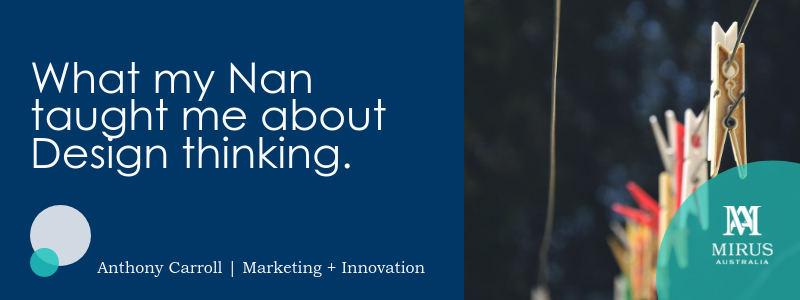What my Nan taught me about Design thinking with Anthony Carroll
February 23, 2019 | Aged Care Management

Do you know everything or are you occasionally reminded of the things you don’t know or have forgotten? It’s easy to get ‘caught up’ in what we do every day and focus on just the work in front of us. Psychologists call this ‘cognitive bias’, that is, we tend to gravitate towards the things we know rather than things we don’t. As a result, we don’t always practice what we preach.
I teach Design thinking at Sydney University’s Centre for Continuing Education every couple of months. I also practice Design thinking at work each day, operationally and with our clients. At the core of Design thinking is empathy. Empathy is the ability to understand a challenge or problem from someone else’s perspective. We teach Design thinking principles continuously and remind our clients to look at their products and services from a customer’s point of view and not the other way around.
Lessons we learn
Earlier this year, my Nan had a fall. She’s 94 years young. One morning she either got out of bed too quickly or miss stepped and as a result fell, breaking her nose. Thankfully she made a great recovery and is now back at home, albeit with some much-needed changes.
Nan’s mind is sharp as a tack. She will read a book in just a few days and hold a conversation about anything and everything. I visited her during rehab, and she explained in more detail about her journey back home. I was momentarily confused because she wasn’t due to go home. She had another week of rehab to manage her balance and help with walking correction. So, I listened as she told me about her trip with her exercise physiologist, Arun. Apparently, Arun took Nan home one day because he wanted to see first-hand what a day looked like for her. She recounted the excursion in detail.
Firstly, Nan had to simulate how she got in and out of bed both at night and morning. Then leaving her bedroom and moving down the hallway, re-enacting her daily morning routine. Each demonstration was always followed by “and then” by Arun to ensure he missed absolutely nothing in her daily activities.
Apparently, the funniest moment came when they entered the kitchen. Nan had just gone through her ritual of washing her clothes. From loading her clothes into the washing machine to turning it on to unloading them again. This is where the sticking point came, and Nan could sense Arun was a little troubled. As Nan went to show him how she unloaded her washing, he asked her where she put the wet and clean clothes? Nan swiftly kicked out a large washing bowl and simulated dropping the wet clothes into the bowl on the floor. With a badly hidden frown (one of knowing how this is going to play out, or he thought he did), Arun tentatively said: “And then?”
Nan promptly kicked the bowl along the floor with her foot to the back door as she walked down the two steps to the backyard, and then along to the waiting clothes dryer. Arun was dismayed. And exclaimed, “No!” in his still very polite and professional manner but offered up some very sound advice. “It would be best, Mrs Bea, if you got someone else to do your washing from now on”
Hallelujah! I thought as I listened to Nan recounting the moment. Nan cherishes her independence, as we all do, and desperately wants to demonstrate how she remains so.
Nan’s story taught me . . .
Nan’s story highlighted two important things about Design thinking. Firstly, Design thinking can be used for everything! Regardless of what it is, the process remains the same.
Arun’s sojourn to Nan’s place demonstrated this beautifully. He wanted to see things from her perspective, before making any assumptions and importantly, before offering any solutions. Arun is an experienced Exercise Physiologist and has no doubt seen many similar cases to my Nan’s. So, he could’ve easily made assumptions and provided a ‘tried and tested’ solution that has been implemented before.
But Arun chose a different path, which brings me to the second lesson. Arun ensured Nan felt unique. He made her feel that her journey was hers, and hers alone, and wanted to view it for himself. He put Nan right in the centre. That’s exactly how Design thinking should work and the human-centred approach underpins design thinking. The two terms can be used interchangeably to describe the same methodology.
In summary
We can be good at gathering insights from customers to understand their problem, but sometimes we forget to take them along on the journey with us to solve it. Don’t use customers as bookends. Include them throughout the process to ensure you get their timely and key insights as you build the solution for them. It’s less expensive to tweak and iterate before you go to market than it is afterwards.
Nan is back at home now and has agreed to have someone help with her washing. Hallelujah!
About the author: Anthony Carroll provides facilitation and training in Design thinking/Human-Centred design for organisations. Design thinking enables organisations to adopt a customer-centered approach to solving problems and challenges, leading to innovation and better customer experiences. Anthony is also a senior member of the Mirus Marketing Team. For more information on Mirus Marketing including Design thinking / Human-Centered design, please click here. To connect with Anthony on Linkedin, please click here.


